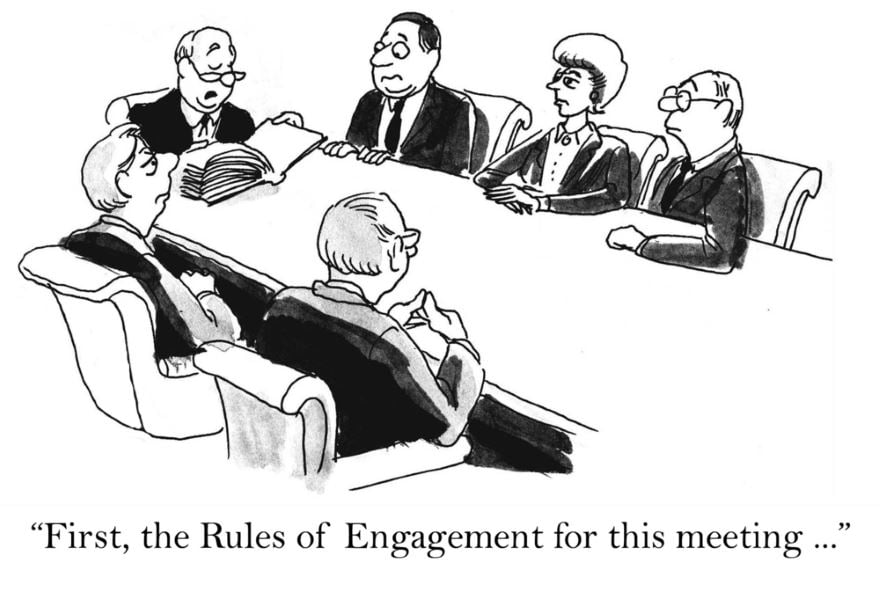A mastermind group is one of the most powerful tools you can use for success. This is a group of people that are determined to meet their individual goals, who share knowledge and experience with each other and help solve problems and develop ideas for success.
Mastermind groups can give you honest feedback, help hold you accountable, and celebrate your success. They build synergy and help reduce the learning curve. Mastermind groups meet on a regular basis and can meet in person or virtually. Anyone can create or join a mastermind group.
In this article we’ll share 9 tips to make your mastermind group a success.
1. Define the Group and Develop Clear Goals

Image via Tiko Aramyan / shutterstock.com
Mastermind Groups can be about anything, but they should be focused on something specific. Is the group about business? Leadership? Personal success? This can be as simple as giving it a title and writing a mission statement. Be sure to read this mission statement for the first meeting so everyone is familiar with the group’s purpose.
Be clear about what the group is about and who it’s for. This will tell potential members why this group is worth their time and effort and that the group’s goals are aligned with their own. Members need a clear understanding of what’s involved and what’s expected.
2. Choose Group Members Carefully

Image via Rawpixel.com / shutterstock.com
One of the failure-points of a group is members not matching the ideals of the group. Choose group members that are a good fit to the Mastermind group’s goals and purpose. This comes through good communication.
Create a dynamic team by getting members from a variety of fields, backgrounds, personalities, strengths, and experience. Create a balanced team. You don’t want a group that’s full of ideas but have no one that’s willing to question those ideas or to take risks.
Even if the group members are from the same field you’ll need a variety of traits and personalities. If there is no variety then everyone will think alike and there won’t be any real solutions to problems. People who are outside your industry might have ideas you wouldn’t have thought of.
Look for a variety of traits such as: organized, disciplined, creative, positive, intuitive, practical, strategic, persistent, easy-going, outgoing, decisive, risk-taker, and patience.
Mastermind groups are give and take. Choose group members that are willing to do both and are fully committed to the group. They should make a commitment to be at every meeting, be open to advice, give advice and support, and be respectful of others and of the group rules.
Don’t choose members that are direct competitors. It will be easier for members to share ideas if they’re not competing with those they’re sharing the ideas with.
Invite people you respect or have inspired you.
Screen your applicants. Use an online survey or short chat to help determine if potential members are a good fit. Ask questions such as:
- Will you have time to participate in the Mastermind Group?
- What is your mission or vision statement?
- What are your 3-year goals?
- Why should you be chosen for membership in this group?
3. Keep the Group to a Manageable Size

Image via Nutela Pancake / shutterstock.com
Keep the size of the group to a number that you can manage and where everyone is getting the most out of the group. Most prefer to keep the size around 5-8 people, but it’s possible to have a successful group with fewer or much more than that.
If your group is so large that everyone doesn’t get to participate fully in the sessions, consider breaking the group into multiple groups. I recommend building a matrix with traits and plan the groups for the best balance possible.
4. Prepare for the Sessions Ahead of Time

Image via wavebreakmedia / shutterstock.com
Unpreparedness wastes precious session time. Provide everyone with a list of what to bring to the session. This could be a printed list that you give them at the end of each session, an email you send out, or an online document that everyone has access to. If you use a shared document everyone can place their own links and tips.
Set up a Facebook or LinkedIn group for communication (I don’t recommend using Facebook for the meeting though, because it can be a distraction), send email, etc.
Have a group agenda for each meeting. Members should be prepared to discuss topics such as:
- One thing that is working well.
- One thing they are struggling with.
- A resource they’ve found helpful this week. It could be an article, book, podcast, service, tip, website, etc.
Have each person share something they’re proud of. This can be an accomplishment, a breakthrough, something good that’s happened for them, etc.
5. Create Clear Session Rules and Structure

Image via Cartoon Resource / shutterstock.com
There’s no one “right way” to hold a meeting. Try several formats and see what works best for your group. Develop meeting rules and read the rules for the first meeting to ensure that everyone is on the same page.
Keep to the agreed structure. If everyone is allowed 10 minutes don’t allow someone to go over. Another option is to have each session to focus on one person. This works better for smaller groups. Change who goes first from one meeting to the next. This way if people tend to get tired and tune out toward the end of the meeting, the same people are not tuned out each meeting.
Keep conversations on topic and ensure the conversations focus on the person that’s in the spotlight for that portion of the meeting. Don’t allow others to make that moment about them or to have unrelated conversations. Keep the meetings on target in both time and scope. Members should give their undivided attention. Everyone is there to help each other and to be helped. They should listen and offer feedback to everyone equally.
Use a projector if possible. This allows group members to bring charts, websites, or other supporting material. It also means everyone is looking forward and listening to the speaker rather than at a laptop or smartphone, which offer their own distractions.
Encourage everyone to set their ego aside. Don’t worry about making mistakes, your ideas sounding silly, etc. Avoid negativity. Use empowering language. Focus on the positive.
Ensure that advice given is clear. If someone offers advice and it isn’t clear ask them to explain further and provide examples. Member’s goals should be written down and shared with the group. This can be done through email, within a Facebook or LinkedIn group, Google shared document, etc.
Participation is key. Each person should be held accountable for their commitments within the group. This includes attending group meetings, performing actions that you commit to, bringing to the meetings what you’re committed to bring, and helping others brainstorm through their issues.
Food is great for meetings. Allow for some fun too.
6. Meet Regularly in a Distraction-Free Location

Image via Tono Balaguer / shutterstock.com
Have a clear and regular schedule. Meeting on a regular basis will help keep momentum going. Choose what works best for your group, based on the types of ideas that need to be implemented from one session to another. Weekly, bi-weekly, or monthly are popular options.
Choose a location that’s free of distractions. A conference room, coffee shop, hotel lobby (for larger hotels), library, or even a group-member’s home can be great choices for meeting as long as there are no interruptions.
Don’t let distance get in the way. Virtual meetings can work great for mastermind groups. Google Hangouts or any type of teleconferencing is a great choice. Just be sure that everyone involved is able to attend without distractions and that everyone is familiar with the online platform.
7. Develop Strong Facilitator Skills

Image via one photo / shutterstock.com
The group needs a facilitator that is capable of running goal-oriented meetings, brainstorming to find best solutions, and holding the group accountable. The facilitator needs to take charge, send out reminders, hold the sessions, motivate group members, and enforce the rules. It helps if you develop your leadership skills.
A mastermind facilitator is not a boss or a parent. They should build trust and rapport in order to lead group members in helping others and guide the discussions. It helps to highlight the benefits of utilizing the group and remind everyone about why they want to reach their goals and reaching success.
Facilitating is about encouragement and offering advice, not judging their decisions and policing them. Use encouraging words when members don’t accomplish tasks they’ve committed to. Recognize efforts. Applaud others when milestones and goals are reached. Help members break larger goals into smaller milestones.
Track members’ accomplishments. Hold them accountable without getting personal. Raise awareness to those that are constantly not meeting their goals and encourage them to use the group to help solve these issues. Encourage them to get an accountability partner if needed.
If someone consistently doesn’t participate as promised, be prepared to ask them to leave the group. This type of behavior can have a negative impact on the group.
8. Consider Charging a Fee

Image via Tharakorn / shutterstock.com
It isn’t the best choice for every group, but it is possible to charge a membership fee. Members are more likely to participate and be more committed to something they’ve paid for. This participation will help improve the value of the mastermind group. If it doesn’t cost them anything but time, it’s more likely to be set aside if something comes up.
If you’ve developed facilitator skills and can help guide the members, essentially coaching and consulting, the mastermind group is even more valuable and you can charge even more.
9. Make Changes as Needed

Image via OoddySmile Studio / shutterstock.com
Make notes about the performance of the mastermind group as a whole to see what’s working and what’s not. If something isn’t working don’t be afraid to change it. Have a suggestion box or schedule a review meeting to discuss issues where the group members would like to see improvements and have the group make suggestions.
Ending Thoughts
A successful mastermind group is a win/win for all group members. They are a great way to create success within any topic. Each group member get the support and encouragement they need, ideas are developed, and it even helps build friendships. Building a successful mastermind group is not easy, but these 9 tips can help grow your mastermind group and make it a success for everyone involved.
We want to hear from you. Have you tried any of these tips with your mastermind group? Let us know about your experience in the comments.
Featured Image via Line – design / shutterstock.com
The post 9 Tips to Make Your Mastermind Group a Success appeared first on Elegant Themes Blog.
